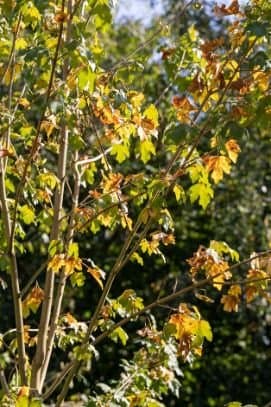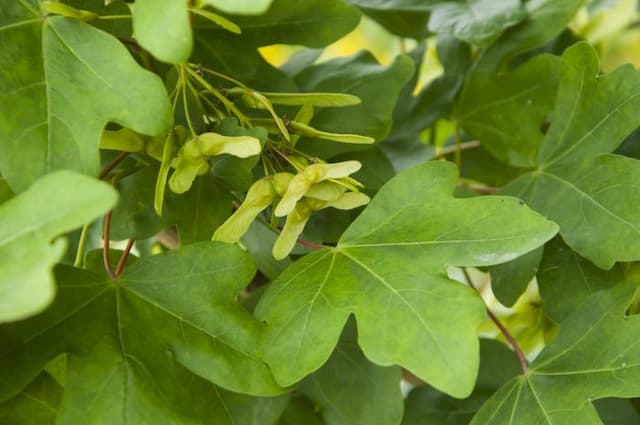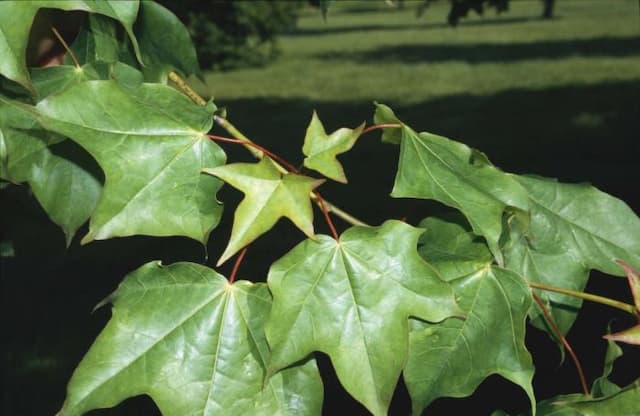Globe Norway Maple Acer platanoides 'Globosum'

ABOUT
The Norway maple 'Globosum', often known for its unique rounded shape, stands out with its dense and neatly symmetrical crown. This well-proportioned deciduous tree displays a luscious, deep green canopy with broad leaves that have a classic maple shape, boasting five distinctive lobes with finely toothed margins. The leafy dome emerges with a delightful hint of reddish tint in spring, transitions to a steadfast green in summer, and then treats onlookers to a glorious display of yellow hues in the fall, signaling the change of seasons. Small, attractive yellow-green flowers may be observed in clusters as the foliage unfolds, providing an additional visual interest and attracting pollinators to the garden. The bark of the tree maintains a subtle grey-brown shade, presenting a smooth texture that becomes more rugged with age. This variety, appreciated for its ornamental qualities, caters to the aesthetic of structured landscapes and gardens desiring a focal point with its pronounced, globe-like shape. Notable for its visual charm throughout the seasons, the Norway maple 'Globosum' is admired for its striking foliage and harmonious form, minus the discussion of its specific dimensions.
About this plant
 Names
NamesFamily
Sapindaceae
Synonyms
Globe Norway Maple, Globosum Norway Maple
Common names
Acer platanoides 'Globosum'.
 Toxicity
ToxicityTo humans
Norway maple is generally not considered poisonous to humans. While not typically eaten, there are no widespread reports of toxicity from ingesting parts of this plant. However, as with any plant, individual allergies or sensitivities could occur, and caution should be exercised.
To pets
Norway maple is not known to be toxic to pets. It is not listed among the common poisonous plants that affect dogs and cats. However, ingestion of large quantities of leaves or other plant material might cause mild gastrointestinal upset due to the fiber content, as with eating non-food plants in general. Owners should still prevent pets from excessive consumption to avoid any potential stomach discomfort.
 Characteristics
CharacteristicsLife cycle
Perennials
Foliage type
Deciduous
Color of leaves
Green
Flower color
Yellow
Height
15 feet [4.57 meters]
Spread
15 feet [4.57 meters]
Plant type
Tree
Hardiness zones
4
Native area
Europe
Benefits
 General Benefits
General Benefits- Compact Size: Acer platanoides 'Globosum', commonly known as the Globe Norway Maple, has a naturally spherical crown, which makes it suitable for small gardens and spaces.
- Shade Providing: Its dense canopy offers generous shade, making it ideal for parks and gardens.
- Ornamental Value: The tree boasts a pleasing form and attractive foliage that turns yellow in the fall, adding aesthetic appeal to landscapes.
- Urban Tolerant: This cultivar adapts well to urban conditions, including pollution and compacted soils, making it a versatile choice for city planting.
- Low Maintenance: Requires minimal pruning due to its naturally rounded crown, reducing upkeep efforts.
- Durable: It is generally resistant to wind and snow damage, providing a reliable structural presence in planted areas.
 Medical Properties
Medical PropertiesThis plant is not used for medical purposes.
 Air-purifying Qualities
Air-purifying QualitiesThis plant is not specifically known for air purifying qualities.
 Other Uses
Other Uses- Acer platanoides 'Globosum', commonly known as the Norway maple 'Globosum', can be used as a natural dye source, where different parts of the plant, such as the bark, can produce varying hues on textiles.
- Wood from the Norway maple 'Globosum' can be utilized in woodworking projects, such as the crafting of small wooden objects, due to its fine grain and workable nature.
- The canopy of this tree offers a strategic shading solution in urban planning, providing natural cooling for streets and buildings beneath.
- The dense foliage of the Norway maple 'Globosum' provides privacy screening in residential landscapes, creating natural green walls between properties.
- Its symmetrical canopy can be used in reflective garden designs where the tree's shape is mirrored in water features or alongside sculptural elements.
- As an educational tool, the Norway maple 'Globosum' serves in dendrology studies to demonstrate the impact of selective breeding on tree form and function.
- Leaves from the Norway maple 'Globosum' can be used in composting to add valuable nutrients and organic matter to garden soils.
- Branches pruned from the tree can be repurposed into stakes and supports for other plants in the garden.
- Instruments such as wooden flutes and recorders can be made from the Norway maple 'Globosum' wood, appreciated for its acoustic properties.
- The smooth, round canopy and distinct leaf shape of the Norway maple 'Globosum' can be implemented in landscape art and photography to add aesthetic value and distinctive silhouettes.
Interesting Facts
 Feng Shui
Feng ShuiThe Norway Maple is not used in Feng Shui practice.
 Zodiac Sign Compitability
Zodiac Sign CompitabilityThe Norway Maple is not used in astrology practice.
 Plant Symbolism
Plant Symbolism- Longevity and Strength: Acer platanoides 'Globosum', more commonly known as the 'Globosum' Norway maple, often symbolizes longevity and strength due to its hardy nature and the longevity of the maple tree species.
- Balance: The rounded, symmetrical crown of the 'Globosum' cultivar can represent balance and harmony in one's life.
- Independence: Maples are known for their ability to grow and thrive independently, which can be interpreted as a sign of self-sufficiency and personal growth.
 Water
WaterThe Globe Norway Maple should be watered deeply and regularly during its first growing season to establish a deep root system. After establishment, water the tree less frequently, but still deeply, to encourage root growth. Typically, providing 1 to 1.5 gallons of water once a week should suffice, with increased amounts during periods of drought. Overwatering or allowing the tree to sit in soggy soil can lead to root rot, so ensure the soil drains well.
 Light
LightThe Globe Norway Maple thrives in full sun to partial shade. It is best situated in a location where it receives at least six hours of direct sunlight daily, but it can tolerate some light shade, especially during the hot afternoon hours. Avoid deep shade, as this can lead to reduced vigor and sparse foliage.
 Temperature
TemperatureThe Globe Norway Maple can withstand a wide range of temperatures, suitable for USDA zones 4 through 7. It can survive minimum winter temperatures down to -30°F and can handle summer temperatures well into the high 80s°F. The ideal temperature range for this maple is between 50°F and 75°F to encourage optimal growth.
 Pruning
PruningThe Globe Norway Maple should be pruned to shape it and remove any damaged or diseased branches, best done in late winter or early spring before the sap starts to flow. Prune sparingly to maintain its natural round shape, and avoid heavy pruning as this can lead to excessive growth of undesirable shoots. Inspect the tree annually for pruning needs.
 Cleaning
CleaningAs needed
 Soil
SoilThe Norway Maple 'Globosum' flourishes in well-draining, moist, fertile soil with a pH range of 4.0 to 7.0. A soil mix with ample organic matter such as compost or leaf mold will aid in water retention and nutrient supply.
 Repotting
RepottingNorway Maple 'Globosum' trees planted in containers may need repotting every 3 to 5 years to prevent root-bound conditions and refresh the soil.
 Humidity & Misting
Humidity & MistingNorway Maple 'Globosum' is adaptable to a wide range of humidity levels outdoors and does not have specific humidity requirements.
 Suitable locations
Suitable locationsIndoor
Growing 'Globosum' indoors isn't practical due to size.
Outdoor
Plant in full sun to partial shade and mulch root area.
Hardiness zone
4-7 USDA
 Life cycle
Life cycleThe Norway Maple 'Globosum' begins its life when a viable seed from a mature tree germinates in a suitable environment, typically in spring. After germination, the seedling emerges and establishes roots and shoots, entering the juvenile growth phase where it focuses on developing a robust root system and foliage. As the sapling grows, it enters a vegetative state, characterized by the expansion of its distinctive globe-shaped crown made up of dense, lush foliage. Over several years, the tree reaches maturity and begins to reproduce, producing small yellow-green flowers in early spring that are followed by the development of characteristic winged fruits called samaras. These samaras disperse by wind, allowing new seeds to spread and potentially germinate to continue the species' life cycle. In its mature stage, the Norway Maple 'Globosum' can live for decades, contributing to the ecosystem by providing shade, habitat, and seasonal autumn color before eventually senescing and dying, completing its life cycle.
 Propogation
PropogationPropogation time
Spring-early summer
The Norway Maple 'Globosum', scientifically known as Acer platanoides 'Globosum', is commonly propagated by grafting, which is the most popular method for this particular cultivar. Grafting is usually performed in late winter or early spring before the sap begins to flow. The process involves taking a scion, which is a cutting from a desired parent tree that includes buds, and attaching it to a rootstock, which is a seedling or a young tree that provides the root system. The scion and the rootstock are cut at matching angles, bound with grafting tape and often sealed with wax to prevent drying out. This joins the vascular systems of the two, allowing them to grow together and form a new tree that possesses the desired characteristics of the 'Globosum' canopy but with the hardiness of the rootstock's root system.







![Freeman maple [Autumn Blaze]](/_next/image?url=https%3A%2F%2Fplants-admin.emdemapps.com%2Fimages%2Fplants%2F%2Fimages%2F604b575b84d87.png&w=640&q=75)

